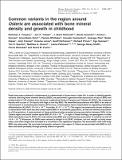Common variants in the region around Osterix are associated with bone mineral density and growth in childhood
Author(s)
Peltonen, Leena; Timpson, Nicholas J.; Tobias, Jon H.; Richards, J. Brent; Soranzo, Nicole; Duncan, Emma L.; Sims, Anne-Marie; Whittaker, Pamela; Kumanduri, Vasudev; Zhai, Guangju; Glaser, Beate; Eisman, John; Jones, Graeme; Nicholson, Geoff; Prince, Richard; Seeman, Ego; Spector, Tim D.; Brown, Matthew A.; Davey-Smith, George; Deloukas, Panos; Evans, David M.; ... Show more Show less
DownloadTimpson-2009-Common variants in the region around.pdf (162.2Kb)
PUBLISHER_CC
Publisher with Creative Commons License
Creative Commons Attribution
Terms of use
Metadata
Show full item recordAbstract
Peak bone mass achieved in adolescence is a determinant of bone mass in later life. In order to identify genetic variants affecting bone mineral density (BMD), we performed a genome-wide association study of BMD and related traits in 1518 children from the Avon Longitudinal Study of Parents and Children (ALSPAC). We compared results with a scan of 134 adults with high or low hip BMD. We identified associations with BMD in an area of chromosome 12 containing the Osterix (SP7) locus, a transcription factor responsible for regulating osteoblast differentiation (ALSPAC: P = 5.8 × 10[superscript −4]; Australia: P = 3.7 × 10[superscript −4]). This region has previously shown evidence of association with adult hip and lumbar spine BMD in an Icelandic population, as well as nominal association in a UK population. A meta-analysis of these existing studies revealed strong association between SNPs in the Osterix region and adult lumbar spine BMD (P = 9.9 × 10[superscript −11). In light of these findings, we genotyped a further 3692 individuals from ALSPAC who had whole body BMD and confirmed the association in children as well (P = 5.4 × 10[superscript −5]). Moreover, all SNPs were related to height in ALSPAC children, but not weight or body mass index, and when height was included as a covariate in the regression equation, the association with total body BMD was attenuated. We conclude that genetic variants in the region of Osterix are associated with BMD in children and adults probably through primary effects on growth.
Date issued
2009-01Department
Broad Institute of MIT and HarvardJournal
Human Molecular Genetics
Publisher
Oxford University Press (OUP)
Citation
Timpson, N. J. et al. “Common Variants in the Region Around Osterix Are Associated with Bone Mineral Density and Growth in Childhood.” Human Molecular Genetics 18.8 (2009): 1510–1517.
Version: Final published version
ISSN
0964-6906
1460-2083